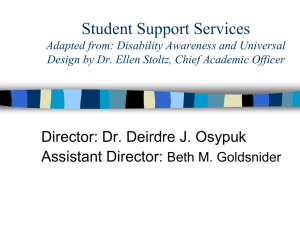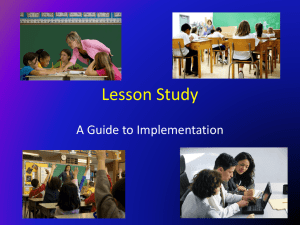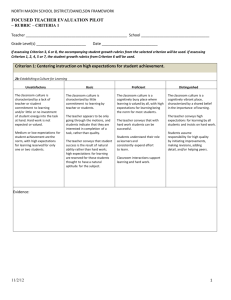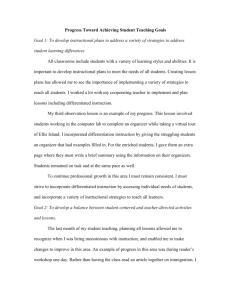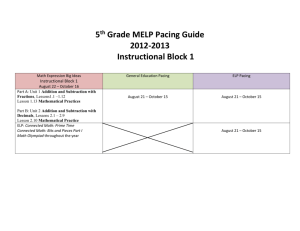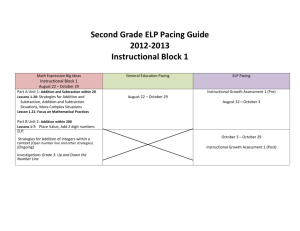PPT - Prince George`s County Public School System
advertisement
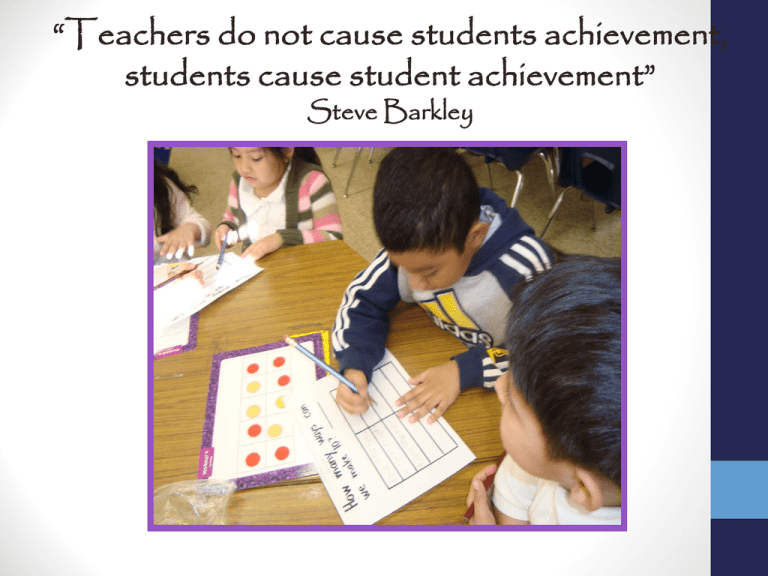
“Teachers do not cause students achievement, students cause student achievement” Steve Barkley Framework for Teaching Evidence: What it Looks Like Prince George’s County Public Schools Office of Talent Development Objectives • Identify evidence to be included in the FfT Descriptors of Practice. • Identify and collect non-bias and factual evidence from on stage and off stage • Analyze a completed Descriptors of Practice Agenda Part I: • Warm Up • What is evidence ? Part II: • Collecting off-stage Evidence Domain 1 • Identify Evidence for Domains 1, 2 and 3 Part III: • Looking at a completed D.O.P. Closure • What are the implications for you as a teacher? Part I What is evidence? Quick Write What is evidence? EVIDENCE Evidence is a factual reporting of events. It may include teacher and student actions and/or behaviors. It may also include artifacts prepared by the teacher, students, or others. It is not clouded with personal opinion or biases. It is selected using professional judgment by the observer and/or the teacher. Types of Observation Evidence • Verbatim scripting of teacher or student comments: “Could one person from each table collect materials?” • Non-evaluative statements of observed teacher or student behavior: The teacher stands by the door, greeting students as they enter. • Numeric information about time, student participation, resource use, etc.: Three students of the eighteen offer nearly all of the comments during discussion. • An observed aspect of the environment: The assignment is on the board for students to do while roll is taken. BIAS When making judgments based on evidence, we draw conclusions from what we see and hear. And, while it is human nature to attach positive or negative “meaning” to elements in our environment, it is inappropriate in a professional observation to allow our personal associations – our biases – to affect our judgment. Exploring the nature of bias: Bias, both personal and societal, can influence judgment in many ways. None of these influences, it should be noted, are directly related to the teacher’s effectiveness in the classroom, but they can affect the observer’s judgment. Bias is both possible and important to understand. Threats to evaluator accuracy: • Assessor bias • Leniency • Central Tendency • “Halo” or “Horns” Effect • Comparison 4 o’clock appt. On the Line • You will view pieces of statement and determine if the evidence is evidence or an opinion. • If the statement is evidence step forward, if opinion then step backward, and if you are not certain, then stay on the line. Evidence or Opinion? The pacing of the lesson was slow, allowing for student restlessness, disengagement, and disruptive behavior. Evidence or Opinion? The teacher says today’s activities are an extension of the math unit. Evidence or Opinion? The pacing of the lesson was slow, allowing for student restlessness, disengagement, and disruptive behavior. Evidence or Opinion? The new table arrangement encourages concentration and controlled interaction with neighbor. Review - What is Evidence? • Actions, by teacher or students • Statements or questions, by teacher or students • Observable features of the classroom • Captured not remembered The 8 Essential Components Domain 1: Domain 2: Planning and Preparation Classroom Environment 1c: Establishing Instructional Outcomes 2b: Establishing a Culture for Learning 1e: Designing Coherent Instruction 2d: Managing Student Behavior Domain 4: Domain 3: Professional Responsibility Instruction 4a: Reflecting on Teaching 3b: Using Questioning and Discussion Techniques 4c: Communicating with Families 3c: Engaging Student in Learning Pieces of the Lesson • Value, Sequence, & Alignment • Aligned to standards • Part of a bigger picture, previous lesson, beginning lesson, etc. • Represents high expectations & intellectual rigor (higher order thinking) • Clarity • • • • Objectives use measurable verbs Clearly stated as a learning goal & can be assessed Teacher states outcome as learning not just as an activity Outcomes can be assessed/tested Pieces of the Lesson Balance: • Balance represent factual knowledge and procedural skills as well as thinking and reasoning, conceptual understanding and skills in collaboration. • Among different types of learning (may represent listening, discussion, writing, drawing, presenting, groupings, etc.) How is it related to the learning outcome? • Integrated with other content areas/technology • Instruction is adjusted to accommodate diverse learners • Differentiating the Process/Activities o Differentiating the processes means varying learning activities or strategies to provide appropriate methods for students to explore the concepts. 1e: Designing Coherent Instruction Requires teachers’ knowledge of the content, students, resources and clarity of instructional outcomes that come together, resulting in a plan of action. Pieces of the Lesson Learning Activities • Are suitable for students. • Support the Instructional Outcomes in 1c. • Engage students in meaningful learning via approved textbooks, technology, websites, and resources from www.mdk12.org. • Reflect appropriate text complexity. Materials and Resources • Are suitable for students. • Support the Instructional Outcomes in 1c. • Engage students in meaningful learning via approved textbooks, technology, websites, and resources from www.mdk12.org. • Reflect appropriate text complexity. Pieces of the Lesson Instructional Groups • Groups are varied as appropriate, based on needs of students and instructional outcomes. • Student choice is incorporated in grouping decisions. Lesson and Unit Structure • Clearly defined structure • Activities designed to support lesson structure & are coherent • Time allocations are reasonable • Topics are connected • Time for closure and student reflection • Options are provided for diverse student needs. 2b. Establishing a Culture for Learning The culture for learning refers to the atmosphere and energy level in a classroom, where students are engaged in important work. Pieces of the Lesson Importance of Content Atmosphere in class reflects importance of work Everyone engaged in pursuits of value Norms that govern interaction among individuals Students demonstrate curiosity and taking initiative High energy Expectations for Learning & Achievement •High expectations of Teacher •Teacher has confidence in their abilities •Effort is rewarded •Good ideas are valued (Good job, you have two more sentences to go”) •Students put forth effort •Being “smart” is cool •Safe environment for taking risks Pieces of the Lesson Student Pride in Work Student work is displayed Accountable talk (students & teachers) Students explain work to others Students value learning and hard work 2d. Managing Student Behavior • Expectations • Monitoring of Student Behavior • Response to Student Misbehavior 28 Pieces of the Lesson Expectations Standards of conduct set/posted Monitoring of Student Behavior •Self monitoring by students •Teacher aware of what is going on “eyes in the back of the head” Clear consequences Response to Misbehavior Consistently applied (no favorites) Routines/procedures established Teachers refrain from losing temper •Reflects established behavior plan •Proximity of teacher •Consequences based on student behavior, not on the student Pieces of the Lesson Quality of Questions Invite students to formulate hypotheses Make connections Challenge previously held views Promote student thinking/teachers probe student responses High level rather than low level Discussion Techniques •Discussion student led •Teacher not the center of the discussion “sage on the stage” •Requires student analytical thinking •Teacher encourages comments on others answers and requests further elaboration Pieces of the Lesson Student Participation in the Discussion All students are engaged All students are drawn into the conversation Students themselves ensure high levels of participation Pieces of the Lesson Activities ad Assignments • Large (whole class), small, pairs, triads, etc. • Should reflect what teacher is trying to accomplish and should serve that purpose • Heterogeneous/Homogeneous Grouping of Students • Active student learning-mental engagement • Students making contributions • Students are intellectually engaged • Students challenged to think broadly & deeply • Students solve problems Pieces of the Lesson Instructional Materials & Resources •Suitable and enhances learning for all students •Needed for outcome/engaging for students in meaningful learning •Supported the instructional outcomes Structure and Pacing •Students know where they are in the structure •The structure guided the lesson (warm up, beginning, middle, end, and closure) •Pacing is appropriate to students and content •Students don’t feel rushed or too much lag time 4a: Reflection on Teaching (page 92-94) Accuracy • Teacher prompts students to reflect on learning and uses the reflections to assess lesson’s effectiveness. • Teacher identifies specific learning outcomes that students mastered and those that will need to be reinforced with additional instruction. • Teacher reflects on the effectiveness of instructional groups by assigning student monitors in each group to collect data about the participation of each group member. In addition, all students participate in a reflection activity in which they make connections between group participation and learning. 4a: Reflection on Teaching Use in Future Teaching • Teacher provides several alternate resources for students, including options for students of varying levels of readiness and learning style. • Based on student reflections, the teacher regroups student for the next lesson according to their area of interest in the topic. • After examining student work, the teacher develops a series of milestones, sequenced and differentiated according to needs indicated by student work. 4c: Communicating with Families Information about the Instructional Program Informs families how class is run Uses a communication strategy: web page, newsletter, back-to-school night, email, etc. 4c: Communicating with Families Information about Individual Students Parents should feel invited and encouraged to contact the teacher any time Inform parents of academic & social progress Communicates honestly with parents Responds to parent concerns Part II Collecting off-stage Evidence Domain 1 Identifying Evidence for Domains 1, 2 and 3 Domain 1 • Review the sample lesson plan • Record evidence from the sample lesson plan for Domain 1 • Have a discussion with a partner or group about the evidence collected. The Framework for Teaching Charlotte Danielson • Collecting off-stage Evidence Domain 1 D.O.P Take a moment to read through the completed D.O.P. • What do you notice? • Fact or Opinion • Levels of Performance The Framework for Teaching Charlotte Danielson Examining a completed Descriptors of Practice Closure What are the implications for you as a teacher? Quote “The aim of education should be to teach us rather how to think, than what to think - rather to improve our minds, so as to enable us to think for ourselves, than to load the memory with thoughts of other men.” ~Bill Beattie ~






